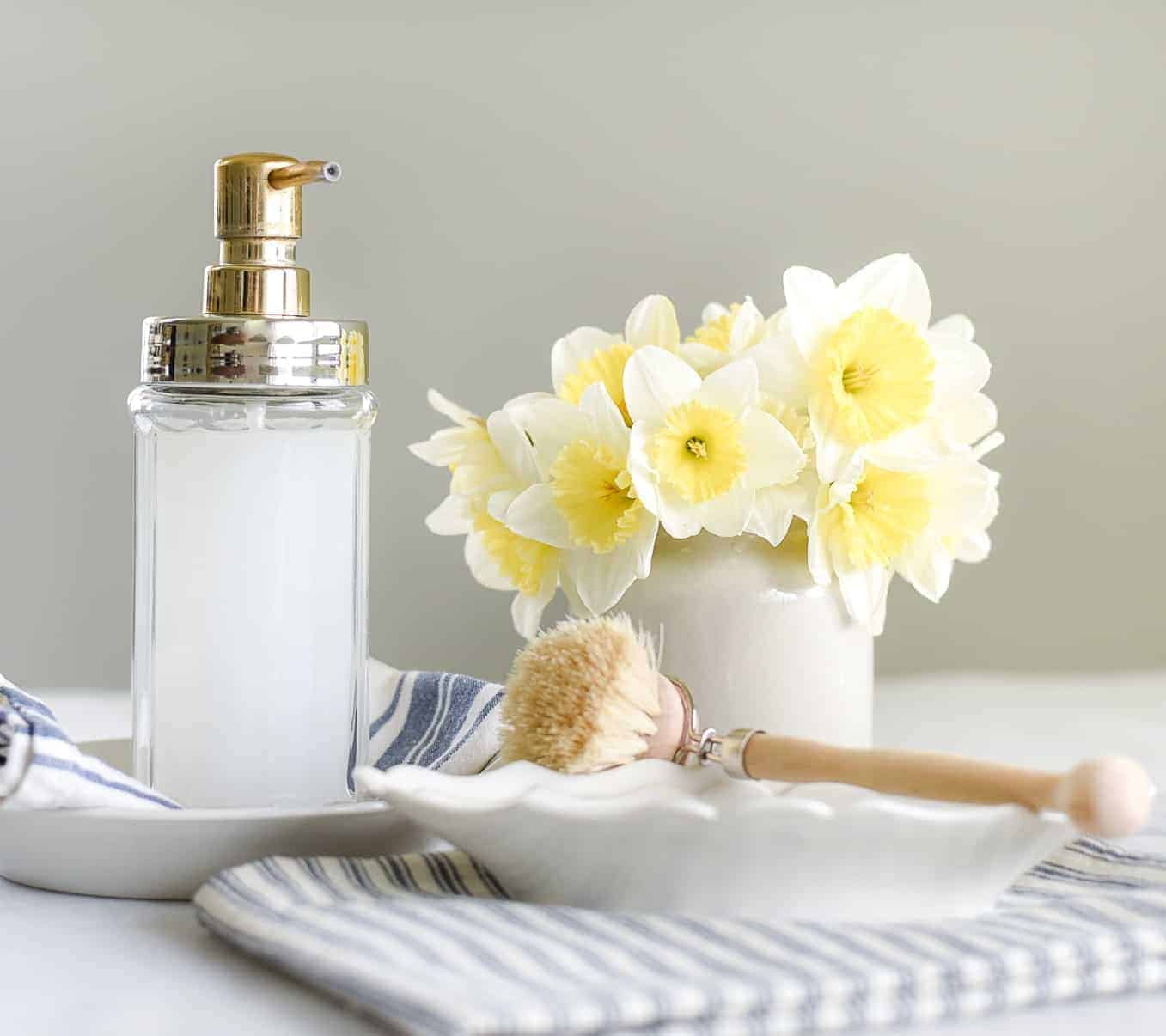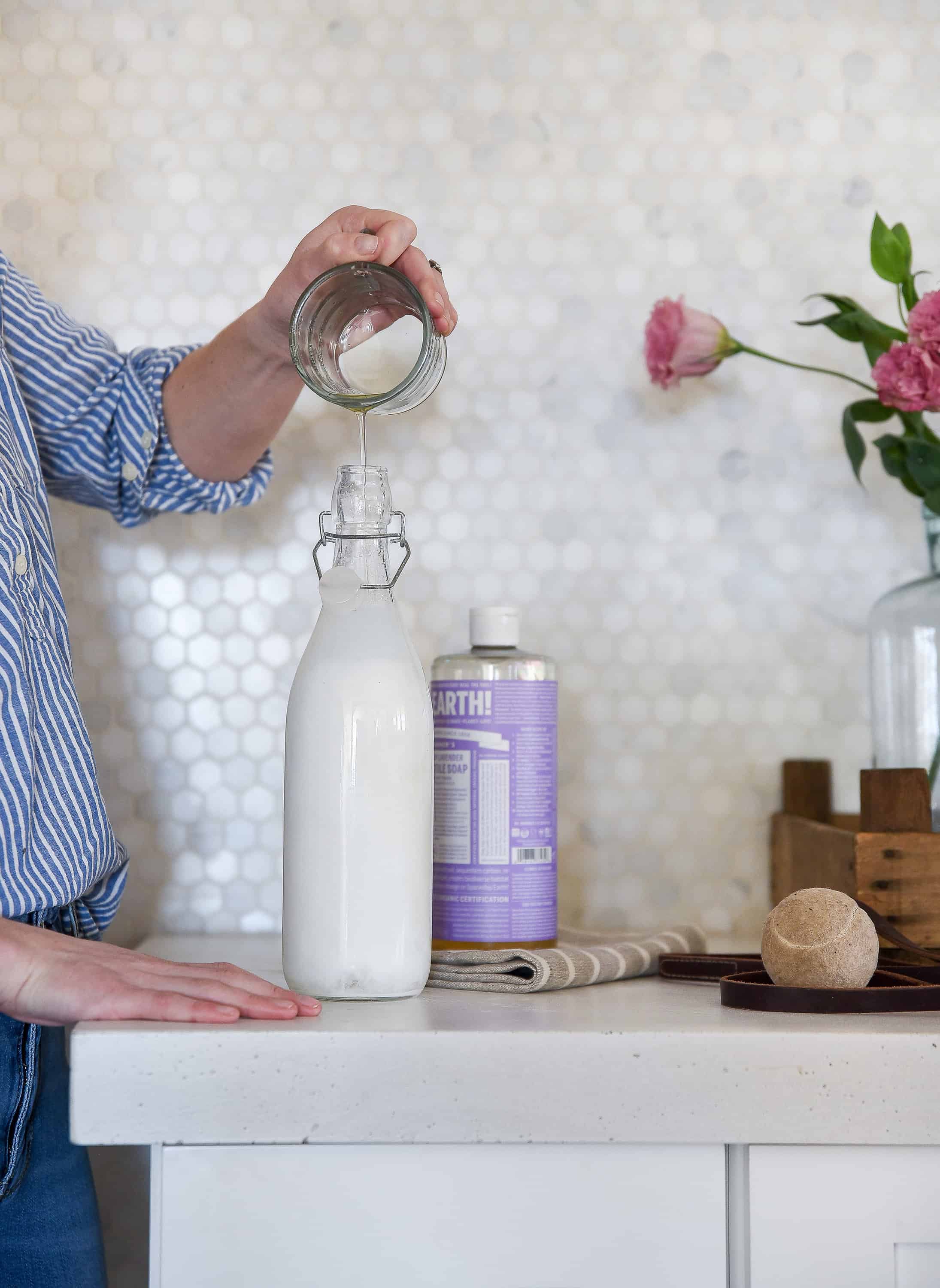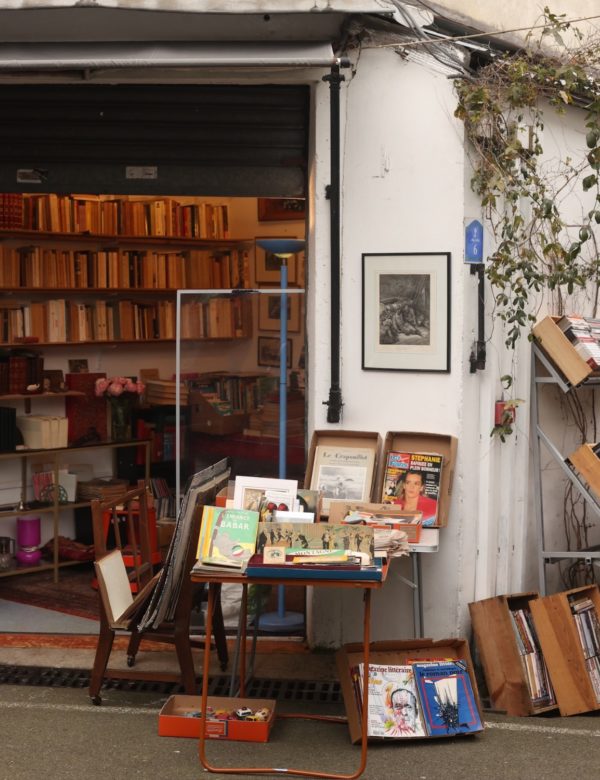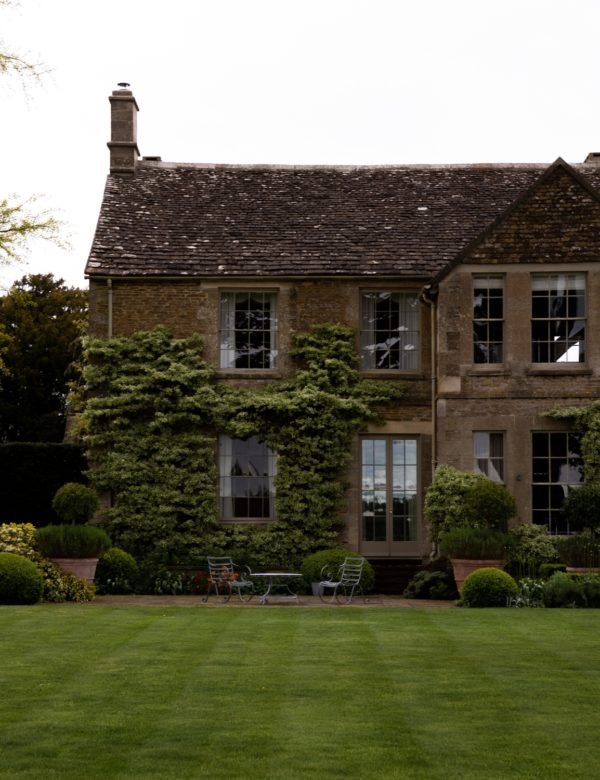Castile soap is one of the oldest known soaps, yet continues to innovate the way we clean our homes today! You can use this simple all-natural soap to clean nearly anything in your home!
Castile soap was an innovative soap in the medieval ages and continues to be useful in modern times. This amazing soap can be used for so many areas of your home and within your lifestyle, it’s a staple for any minimalist home.
My Castile Soap Journey
A few years ago, I swapped all of our hand soap for a homemade hand soap recipe made with Castile soap.
I had seen Castile soap many times for sale in the grocery store, but I wasn’t really sure what it was. I decided to give it a try…and I haven’t looked back since!
Castile soap is one of my favorite green cleaning products. In fact, it’s one of the only things I use on a daily basis to keep our house and our bodies clean!
It can be used for so many things including: shampoo, body wash, hand soap, countertop cleaner, dish soap…and much more.
So, what exactly is Castile soap used for? The uses are endless including: dishwashing soap to laundry detergent, hand soap, countertop spray, and even soft scrub!
This magical green cleaning product is non-toxic and bio-degradable since it is made from plant-based oils rather than animal fat.
The most common brand is Dr. Bronner’s. You can typically find at your grocery store, but it is also available on Amazon and other online retailers. I have found that Target has the best price, Amazon sometimes offers it on sale, and if you can find it at Grocery Outlet, you’ll get a major deal!
It’s important to note: Castile soap comes in a concentrated form, and needs to be diluted in order to use! Follow the dilution suggestions on the bottle for everyday household uses.
Table of Contents
What is Castile Soap?
Castile Soap is a plant based soap made from vegetable oil such as olive, coconut, palm, or any other plant based oil rather than from animal fat.
The soap is made by mixing potassium hydroxide lye with vegetable oil and purified water to create a liquid soap mixture.
Historically, this soap is made using only olive oil; however, modern brands like Dr. Bronner’s often add other vegetable oils such as coconut. The most important thing to remember is that this soap does not use any animal fat or animal byproducts to be made.
If you would like to make your own Castile soap, you absolutely can! You’ll need Potassium hydroxide lye, coconut + olive oil, and distilled water! Of course, making your own soap is a bit time consuming and requires some science, so purchasing it is a bit easier!
How to Dilute Castile Soap in Water
Liquid Castile soap comes in a concentrated form and will always need to be diluted before using. Common dilutions are about 1/4 cup soap to 3-4 cups water for hand soap and dish soap.
I add about 1/4 cup to my laundry (in the normal soap dispenser). For dilution directions, see Dr. Bronner’s Dilution cheat sheet. I do not add the vinegar rinse as recommended on the bottle.
If you mix your own liquid hand soap and find that it is not sudsing enough, just add a little more soap to the mixture. I honestly eye-ball my measurements.
The History of Castile Soap
It is believed that Castile soap originated in the 11th C in Aleppo of the Levant region and moved westward after the first crusades.
When soap was discovered by Europeans after the first crusades, it became popular as it began revolutionizing hygiene.
The crusaders had witnessed how the soap was made during their time spent in the Holy Lands, and attempted to reproduce it.
Eventually, the process made its way to Spain, and while most regions failed at reproducing the high-quality soap, one area in particular was able to get the recipe just right: Castile.
The soap being made in Castile became known for its superiority and became popular with Spanish royalty, which then spread to royalty in other countries.
Originally, the soap was made with laurel oil (bay leaves), but because laurel oil was inaccessible in Spain, olive oil was used because it was available in abundance.
It is believed that Castile soap reached England sometime between 1567 and 1616 and was known by its latin names: sapo hispaniensis (Spanish soap) or of sapo castilliensis (Castilian soap).
In the 17th C, Castile soap became controversial due to its Spanish Catholic ties. During the rein of Charles I, Spanish soap manufacturers purchased the monopoly of soap making; however, Protestant England did not approve of the monopoly of a Catholic manufacturer.
Ultimately, the Spanish manufacturers lost the monopoly after campaigns of wash women showcasing local soaps being superior to Castile soap.

How is Castile Soap Made?
Castile soap was originally made using Laurel (bay leaf) oil and lye (ash); however, as it spread through Europe, olive oil replaced laurel oil due to availability.
It is made by combining lye, also known as caustic soda which is the common name for sodium hydroxide (for hard soaps) or potassium hydroxide (for liquid soaps), plant-based oil, and water.
Lye is highly soluble in water and produces caustic basic solutions. Known for its cleaning abilities, lye is a common ingredient in oven cleaners and drain unclogging solutions because it is a natural degreaser.
When lye is mixed with fat or oil, soap is formed! Similarly to the original recipe, modern day Castile soap is made by combining lye with any type of vegetable or plant-based oil such as avocado, nut/seed, olive (most common), or hemp, among others.
The mixture produces a liquid soap used to clean anything and everything! In modern day brands, the combination of olive oil & coconut oil is perfect for cutting grease without drying skin!
What Can It Be Used For?
Castile soap is one of the most incredible soaps because it can be used for practically anything you need to clean – even your teeth or vegetables!
One of the most commonly available brands is Dr. Bronner’s. This soap comes in a concentrated form, so all you have to do is dilute it to suit your cleaning need!
Dr. Bronner’s dilution cheat sheet is a wonderful asset as you get started using Castile, but eventually you’ll know just how much (or how little) to use for your cleaning routines.

Amazing Uses for Castile Soap
- Shampoo (make sure to use acidic conditioner)
- Vegetable Rinse
- Laundry Soap
- Dish Soap (hand washing only – not for dishwasher)
- Liquid Hand Soap
- Dog Shampoo
- Countertop Spray
- Mopping Solution
- Toilet Bowl Cleaner
- Shower & Tub Cleaner
- Bath Soap
- Facial Soap
- Shaving Soap
- Plant Spray for Bugs
- Window Spray
- Soft Scrub Cleaner
This is just the tip of the iceberg – you can pretty much clean anything in your home with this natural, bio-degradable soap!
Get the recipe for homemade dog shampoo as seen on Martha Stewart
Frequently Asked Questions
Castile Soap FAQ
Does Castile soap get sudsy?
Yes, this soap will suds up just like your traditional dish or hand soap. If it isn't sudsing up, you've probably diluted it too much. It doesn't need to suds up to be effective though!
Can I use the scented soap on my dishes?
Yes, I use lavender scented Castile soap for my laundry, dishes, and hands. I do not notice any scent left behind. You can purchase unscented if you do not like the smell.
Is Castile soap anti-bacterial?
It is not 100% anti-bacterial. Castile soaps work by attaching to dirt and germs and rinsing them away, leaving behind a clean surface.
Adding tea tree oil, which is a natural antibacterial oil, can help make your solution antibacterial, but please note, tea tree oil is toxic to cats.
Is this soap bio-degradable and non-toxic?
Pure Castile soaps are completely bio-degradable and non-toxic. Made with simple, age-old ingredients, you can even use pure Castile soap as a vegetable wash (diluted properly). This makes it safe for your self, your kids, and your pets (including dogs)!
Where can I buy it?
You can find Castile at most grocery stores! This makes it so convenient! You can also purchase it from Amazon or Dr. Bronner’s website.
What can I mix Castile soap with to create green cleaning products?
Castile soap doesn’t need to be mixed with much. In fact mixing it with common green cleaners can actually reverse the cleaning properties of the soap.
Since it is alkaline, do not mix it with vinegar. You will be left with a filmy mess!
Castile soap and baking soda share a similar pH level, and mixing the two together is safe. One of my favorite ways to use this soap is to sprinkle baking soda and a few drops of Castile and water over a dirty surface to create a soft scrub that works like magic! This is how I clean my farm sink when it gets disgusting!
Essential oils in Castile soap:
In addition to lye and oil, essential oils can be added to the soap for fragrance and additional cleaning properties. Dr. Bronner’s soap contains 2% essential oil making it safe for pets and household cleaning (including dishes / vegetable wash).
I’m noticing a film left on glass:
If you notice a film left on glass items after using Castile soap, you can use a diluted vinegar rinse. It’s important to use a vinegar rinse after using the soap. Do not mix vinegar and Castile soap together in the same solution, you will be left with a gunky mess.
When vinegar – an acid – is mixed with Castile soap – a base – they react together which causes the soap to un-saponify. Meaning the soap is reversed back to its original oil base, leaving you with nothing more than oil.
Instead, use this soap as you normally would to clean, then after (if needed) you can use a vinegar rinse. After washing dishes, dip them in a sink full of diluted vinegar and rinse. Or, after cleaning a tub or sink, spray a diluted vinegar spray, give a quick scrub, and rinse. The vinegar dissolves the soap scum build-up from leftover minerals that have reacted with the Castile soap.
Note: I have noticed that if I soak glassware in Castile soap, I am left with a thick film. To get rid of this film, I soak in a diluted vinegar rinse. Remember, it is not safe for dishwashers – so use it for hand washing dishes only!
How to use Castile soap for laundry:
I use Castile soap for all of our laundry. It works wonderfully! For spot treatment, I’m still a fan of Shout! however, I am on the hunt for a good all-natural spot remover.
To use your soap in your washing machine, simply treat it the same way you would normal detergent. I use anywhere from 1/4 cup to 1/2 cup of Castile soap per load. The rose and lavender scents are my favorite and leave our clothes, sheets, and towels smelling wonderful!
On the bottle of Dr. Bronner’s soap, you’ll see that it’s advised to add vinegar to the rinse cycle of your laundry. I do not do this simply because I don’t want to sit and wait to catch the rinse cycle to add the vinegar. Remember, don’t mix vinegar and Castile soap together. Instead, for laundry, I haven’t found vinegar to be necessary. I do not notice any filmy build-up on our clothing.







Hi Chloe, my husband and I wish we could take advantage of the benefits of Castile soap. Unfortunately in our case, we are both skin-sensitive to it. My husband literally breaks out in hives from it.
I mention this here because while we all want to be more health and planet conscious, not everyone can use all of the eco-friendly products available. Skin and other sensitivities can come into play. It’s more about finding which combination of natural products and ingredients works best for each individual.
Cheers, Ardith
Great post! I have been on a sustainable journey towards zero waste since May of last year, and there are so many great DIY recipes for cleaners with Castile soap. This post does a great job of summarizing its qualities – thanks for sharing!
-Jenna ♥
Stay in touch? <a href="https://www.bloglovin.com/blogs/chic-cupcake-5059037">The Chic Cupcake</a>
If you are looking for a great green spot cleaner I am now an avid user of puracy stain remover. The baby one or the regular both work great. I used to use oxyclean for my white slip covers and I hated the toxic smell but now I am fully satisfied with theirs! They sell that at target as well.
you do not have to add anything to castille soap for it to be bactericidal. All soaps have been determined to be bactericides and the labelling “bacteriocidal” has been disallowed by the FDA for this reason, since all soaps are.
I use Dr. Bonner’s peppermint soap full strength as a body wash. Is this recommended?
I use it as a bath and shampoo! You can feel the clean and it leaves younice and fresh. You also get a restful sleep
I love it too! It’s so wonderful! :)
Great article. I’ve been using Dr. Bronners for years, for shaving, bathing, etc. Wonderful stuff and it’s the only soap that makes me really feel clean. I really did get a major deal on it at my local Grocery Outlet. 32 oz bottles of peppermint castille soap for 10.99. So far have bought 8 and continue to buy 1 per week as no one else seems interested. Oh well, it’s my gain!
Very informative points about CastileSoaps and why they are way better than the regular soaps
Thanks for your information you provided. I use this Dr. Bronner’s for everything from my hair to washing the floors with this product and its very easy to use.
it perfect for floor/table/clothes cleaning so comment on that. For my experience, it works perfectly for my face/hand/body/hair/dishes and I would recommend this to anyone who is looking for an easy solution to all, or most, cleaning needs.
can i mix bicarb or baking soda to castile soap in my laundry ?
Hi there, yep! You sure can, just not vinegar. :)
Along with being useful at home, Castile Soaps are quite effective as a body wash and shampoo..
People are oblivious to the fact that scalp therapy shampoos for fast hair growth (obviously with no sulfates, no parabens, no DEA) are even a thing. Persons can now achieve longer hair and possess more alternatives. Undoubtedly worth considering.
Whether you’re discussing alopecia, damaged hair, avoiding skin disorders, fast hair growth, hair and scalp care more often than not, the same thoughts come to mind.
For the most part, you should try to steer clear of hair treatments and products that contain chemicals like parabens, DEA and sulfates.
What’s healthy for your hair is good for your skin also.
Clearly your content above is so accurate for multiple reasons. It avoids the usual mistakes and mistakes most fall into- using ineffective alternatives. Thank you so much!
https://myblog.com
I’m surprised you are promoting Seventh Generation products. My S.G. laundry detergent received an F grade by the EWG. (It says 0% synthetic fragrances, dyes or artificial brighteners on the label, so I thought it was safe.)
People in my area are not aware that shampoos that grow your hair faster and longer (obviously with no sulfates, no parabens, no DEA) are a thing. People can now attain longer hair and achieve more alternatives. For sure worth exploring.
Whether you’re discussing hair loss, hair damage, preventing hair disorders, hair growth, hair care generally, very similar rules come to mind.
As a general rule, you have to steer clear of hair treatments and products that include chemicals such as parabens, DEA and sulfates.
What is good for your hair is good for your skin as well.
For obvious reasons the content here is so accurate for many reasons. It stays away from the usual mistakes and pitfalls too many fall into- getting ineffective alternatives. Thank you so much!
https://myblog.com
I ordered this 1 gallon gar because it works great. When the bottle came there was no cap just the aluminum seal. Was there an extra charge for the cap? I will use the one from the jar I have now.
I ordered this 1 gallon gar because it works great. When the bottle came there was no cap just the aluminum seal. Was there an extra charge for the cap? I will use the one from the jar I have now.
Hello, I’m not sure. Maybe reach out to the seller to ask?
Castille soap is only olive oil as the base oil. adding any other oil makes it something different. Dr Bronner’s product may be a good product… (never tried it) but it is not be definition a castille soap. castille soap produced an entire differemt lather as well, the lather is described as slimey, which does not appeal to many people. the nice thing is that castille soap will usually last much longer than other soaps, and it does not dry out the skin as it does not pull moisture away and does so with out the need to superfat the soap. one last thing.. I do agree we have a right to avoid anaimal fats in our poducts if we believe in this, but we should not suspend reality and declare them ‘none- bio degradable’. they are just as bio-degradable as vegetable based fats.